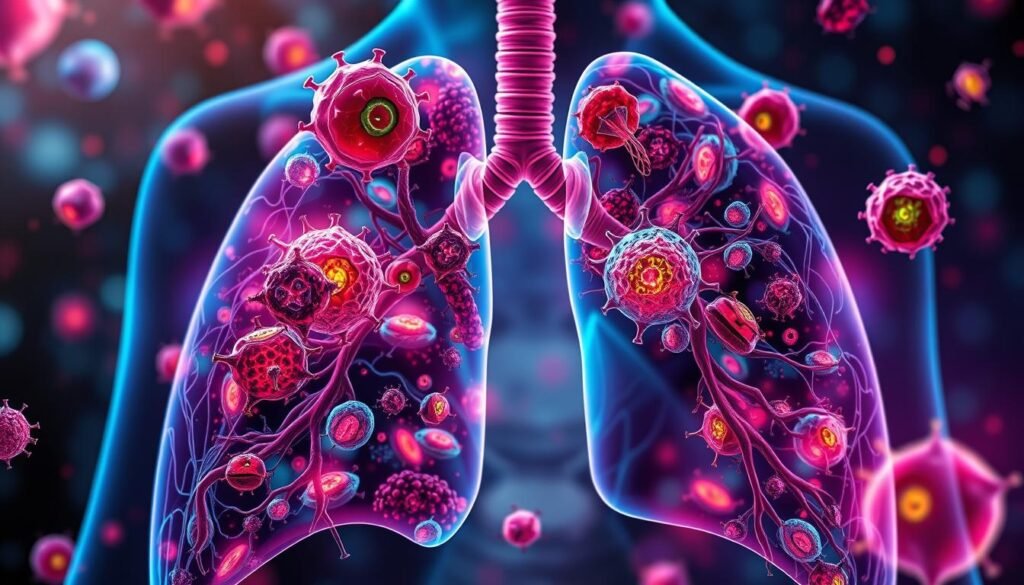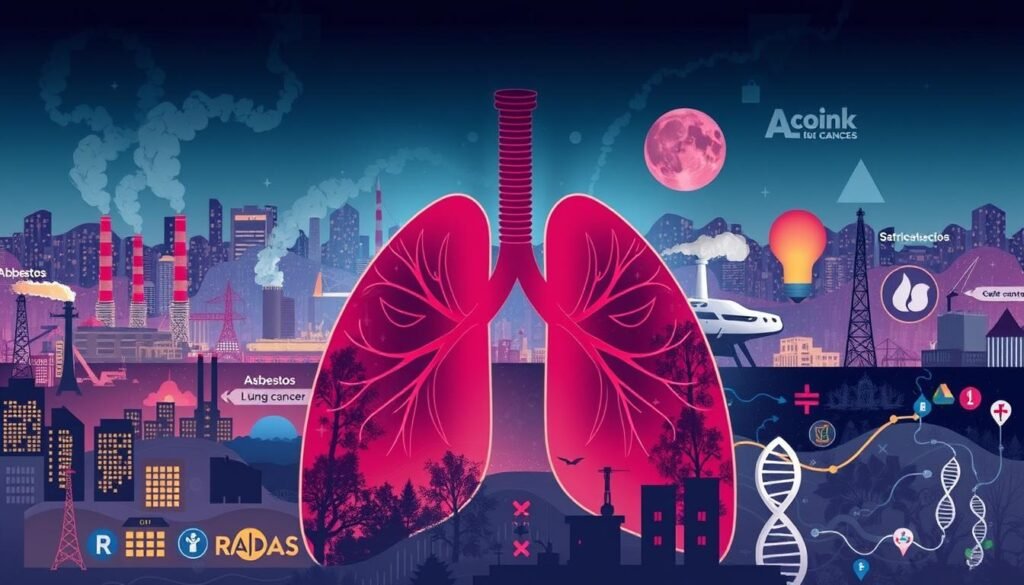Did you know that only 7% of people with small cell lung cancer live over five years? This fact shows how tough lung cancer can be. It is the top reason for cancer deaths worldwide. Knowing about lung cancer is key. Often, patients don’t see symptoms until it’s quite advanced. With new treatments for lung cancer, it’s crucial to get help early to help patients do better.
Even with past treatment challenges, around 60% of patients see good results from first treatments. Yet, treating lung cancer quickly is super important. If not treated, patients have a median survival time of just 3 to 4 months. That’s why catching it early and starting treatment right away matters a lot. Thanks to advances in therapy, there’s new hope for beating lung cancer. It’s very important for both people and doctors to focus on the best treatment plans.
Key Takeaways
- Small cell lung cancer has a daunting five-year survival rate of only 7%.
- Prompt treatment initiation significantly improves survival and symptom management.
- Nearly 60% of patients respond to frontline treatment options.
- The median survival for untreated small cell lung cancer patients is about 3 to 4 months.
- Screening with CT scans can improve mortality rates for lung cancer patients.
Understanding Lung Cancer
Lung cancer is a major health worry in the United States, ranking third in commonality. Each year, about 235,000 new cases of lung cancer are found, affecting many lives. It starts in the lung cells, which are key for breathing. Sadly, lung cancer doesn’t show signs early on. When symptoms like a lasting cough or chest pain show up, it’s often late.
The study of lung cancer involves both its biology and external causes. Smoking is the top factor, linked to 90% of cases. Surprisingly, 60% of cases are in people who stopped smoking. Age plays a role too, with most patients being over 65.
Though lung cancer is fierce, treatment has improved. The survival rate can reach 90% if found early. Treating it involves a team effort to make plans that fit the patient.
Knowing the symptoms of lung cancer and its causes is key to dealing with it. Continuous research helps better treat tough types like small cell lung cancer.
Types of Lung Cancer
Lung cancer splits into two main categories. Each has its own traits and ways to fight it. Knowing these types helps doctors pick the best treatment for patients.
Small Cell Lung Cancer
Small cell lung cancer is pretty aggressive. It makes up about 14% of lung cancer cases. It’s most common in people who have smoked a lot.
This cancer spreads quickly, making treatment challenging. It can move to other parts of the body fast.
Non-Small Cell Lung Cancer
Non-small cell lung cancer is more usual. It includes types like adenocarcinoma, squamous cell carcinoma, and large cell carcinoma. It grows slower than small cell lung cancer.
This gives patients more treatment options. Knowing the difference between these cancers is key for the right treatment plan.
Aggressive Nature of Lung Cancer
Lung cancer is tough to fight. This is because most cases are either non-small cell lung cancer (NSCLC) or small cell lung cancer (SCLC). It spreads fast, making treatments and outcomes difficult for patients.
Characteristics of Lung Cancer Progression
Lung cancer grows quickly and spreads early. Patients soon see their tumor size increase, needing fast medical help. Nearly half of these cancers are lung adenocarcinoma (LUAD), known for its quick and aggressive spread.
This type has certain traits that make it aggressive from the start. Knowing this helps doctors plan better treatments.
Factors Contributing to Aggressiveness
Many things make lung cancer aggressive. Changes in genes, like the TP53 gene in SCLC, play a big role. Smoking and being around carcinogens are also major factors.
A specific kind of lung adenocarcinoma, called C1-LUAD, is especially tough to treat. It loses certain lung cell features, making it prone to mutations and able to avoid immune attacks. To fight lung cancer better, we need to understand these factors.
Lung Cancer Metastasis
Lung cancer metastasis marks a key development in our understanding of the disease’s spread. It can travel through blood, lymph systems, or even nearby tissues. This knowledge is crucial for doctors to stage the disease and plan treatment.
How Lung Cancer Spreads
The spread of lung cancer is complex. Tumor cells can move via blood or lymph to distant organs. This creates new tumors. When cancer spreads like this, it affects the patient’s future. Understanding metastasis is vital for choosing the right treatment.
Common Metastatic Sites
Common metastatic sites for lung cancer include:
- Brain
- Liver
- Bones
Knowing these sites helps in cancer staging and treatment choices. Detecting metastasis early can lead to better patient outcomes and longer survival.

| Metastatic Site | Symptoms | Treatment Options |
|---|---|---|
| Brain | Headaches, seizures, cognitive changes | Surgery, radiation therapy, chemotherapy |
| Liver | Weight loss, jaundice, abdominal pain | Surgery, targeted therapy, chemotherapy |
| Bones | Bone pain, fractures, swelling | Radiation therapy, bisphosphonates, surgery |
Lung Cancer Staging
Understanding lung cancer staging is key for patients and their doctors. This process greatly affects treatment choices and outcomes. It measures how much the cancer has spread at diagnosis. This is crucial for picking the right treatment.
Importance of Accurate Staging
Getting the stage right is very important. It sorts the cancer into groups, which helps plan the best treatment. For example, early-stage lung cancer might be curable with certain treatments. But, later stages might focus more on easing symptoms and improving quality of life.
Stages of Lung Cancer
Lung cancer stages go from Stage 0, or very early cancer, to Stage IV, which means the cancer has spread far. The TNM-8 system is used to determine the stage. It looks at tumor size, if lymph nodes are affected, and if there’s spread to distant parts:
| Stage | Description |
|---|---|
| Stage 0 | Carcinoma in situ, no invasion of surrounding tissues. |
| Stage I | Localized tumor, no lymph nodes involved. |
| Stage II | More advanced local disease, some lymph node involvement. |
| Stage III | Locally advanced disease, extensive lymph node involvement. |
| Stage IV | Metastatic disease, spread to distant organs. |
How Staging Impacts Treatment
The stage of lung cancer greatly determines treatment paths. Early stages might be treated with surgery or targeted therapy for a cure. But, later stages often use treatments like chemotherapy and radiation that address cancer spread. So, the stage of lung cancer sets the course for both treatment and care.
Risk Factors for Lung Cancer
Lung cancer’s risk factors are crucial for understanding the disease. Knowing these factors helps with prevention strategies. The three main categories are smoking, environmental exposures, and genetic predisposition.
Smoking and Lung Cancer
Smoking is the top cause of lung cancer, causing about 80% of deaths. It exposes people to harmful chemicals that increase disease risk. Also, being around smoke can cause lung cancer, making it the third most common cause in the U.S.
The link between smoking and lung cancer is clear. It shows the need for strong programs to stop and prevent smoking.
Environmental Exposures
Things like radon gas and air pollution also affect lung cancer risk. Radon, a radioactive gas, is the second top cause, especially for non-smokers. Also, things like diesel exhaust and some work hazards can make cancer more likely.
Air pollution is linked to 1-2% of lung cancer deaths in the U.S. Working with dangerous substances like asbestos raises risk, especially for smokers. Using coal for cooking can also increase lung cancer rates.
Genetic Predisposition
Having lung cancer in your family suggests a genetic risk. Some people inherit traits that make them more likely to get it. Studies also find certain diseases and conditions can add to this risk.
Understanding these genetic factors helps find those at higher risk. It’s important for better screening.

More information on how allergies and lung health link to cancer risk is available here. For details about how family and environmental factors play a role, see this study.
Lung Cancer Treatments
Treatment for lung cancer varies based on its type and stage. It ranges from surgery and radiation to chemotherapy and targeted therapy. These methods help patients choose the best care plan for them.
Surgical Options
When lung cancer hasn’t spread, surgery is a key option. Techniques like removing part or all of a lung can improve recovery chances. The choice of surgery depends on the tumor’s size, location, and the patient’s health.
Radiation Therapy
Radiation therapy can cure or ease lung cancer symptoms. It uses high-energy beams to kill cancer cells or shrink tumors. This therapy often works with other treatments to be more effective.
Chemotherapy
Chemotherapy is crucial for treating both types of lung cancer. It uses drugs to attack fast-growing cancer cells. Despite its effectiveness, it can cause tough side effects that need managing.
Targeted Therapy for Lung Cancer
Targeted therapy attacks lung cancer’s specific genetic changes. For example, some NSCLC patients have KRAS mutations affecting their outlook. Drugs like KPT-330 are becoming effective, especially when used with other treatments. This method is a step towards treatment based on individual cancer characteristics.
Advancements in Immunotherapy for Lung Cancer
Recent progress in immunotherapy is a big step in battling lung cancer. This method uses the body’s immune system to target cancer better than old ways. It helps the immune system find and attack tumors in different ways.
How Immunotherapy Works
Immunotherapy boosts the immune system’s power to fight cancer. It uses tools like checkpoint inhibitors and monoclonal antibodies. Checkpoint inhibitors, like Nivolumab and Pembrolizumab, stop cancer cells from hiding from the immune system. This wakes up the immune response to fight lung cancer harder. By focusing on specific paths, it tailors treatments for various lung cancer patients, offering new hope in cancer care.
Recent Breakthroughs in Immunotherapy
In recent years, big advances in lung cancer immunotherapy have been made. Treatments that target PD-1 and PD-L1 have changed how we manage non-small cell lung cancer (NSCLC). Studies show that anti-PD-1 checkpoint immunotherapy significantly increases survival rates for some patients. On top of that, research on new drugs targeting LAG-3, VISTA, and TIM-3 is ongoing. These developments provide hope for better treatments for lung cancer patients around the globe.

| Immunotherapy Treatments | Mechanism of Action | FDA Approval Year |
|---|---|---|
| Pembrolizumab | PD-1 inhibitor | 2014 |
| Nivolumab | PD-1 inhibitor | 2015 |
| Atezolizumab | PD-L1 inhibitor | 2016 |
| Durvalumab | PD-L1 inhibitor | 2017 |
| Cemiplimab | PD-1 inhibitor | 2018 |
Lung Cancer Survival Rates
Lung cancer is a major health issue, with survival rates showing how tough this illness is. Knowing the stats gives us insight into what patients face. It also shows how well treatments work.
Current Statistics
The survival numbers for lung cancer are quite sobering. Only about 18.6% live five years after finding out they have it. Non-small cell lung cancer (NSCLC) makes up 85% of cases. Its five-year survival rate drops to 7% when it spreads.
More than half the people with lung cancer pass away within a year of diagnosis. Small cell lung cancer (SCLC) has a median survival of six to twelve months for late stages. Yet, lung carcinoid tumors have a better outlook, with an 85% to 90% five-year survival.
Factors Affecting Survival Rates
Several things greatly impact how long someone with lung cancer might live. These include:
- The kind of lung cancer: SCLC and NSCLC have different survival rates.
- Stage when found: About 40% are diagnosed at stage IV, the most severe.
- Getting to treatment: Early stages might only need surgery, while late stages need tougher treatments.
- Health and age of the patient: Good overall health helps with treatment success.
Lifestyle choices, like smoking, cause at least 80% of lung cancer deaths. Radon and air pollution also play a role. A study from Europe shows small-cell lung cancer often doesn’t have good outcomes. This is especially true for those in late stages. Advances in research and treatment are vital. For deeper insights, check the study on SCLC patient outcomes and analyses here.
Conclusion
Lung cancer is a tough battle, leading in cancer deaths worldwide. It makes up about 13% of new cancer cases. Focused work in lung cancer management shows the value of catching it early and finding new treatments. We’re seeing progress in dealing with aggressive non-small cell lung cancers (NSCLCs), thanks to better knowledge of risks like emphysema and family history.
A team approach is key for the future of lung cancer treatment. It combines the efforts of healthcare workers, researchers, and patient supporters. This teamwork is vital for not just better survival rates but also for giving patients better support and quality of life. Ongoing studies on bettering diagnostic and treatment methods are crucial for fighting this tough disease.
There’s hope for lung cancer patients, thanks to advances in treatment and deeper disease understanding. Research into targeted therapy and new drug mixes could lead to major advancements. This could greatly change lung cancer management and improve patient outcomes. We’re looking forward to these breakthroughs in tackling this challenging illness.